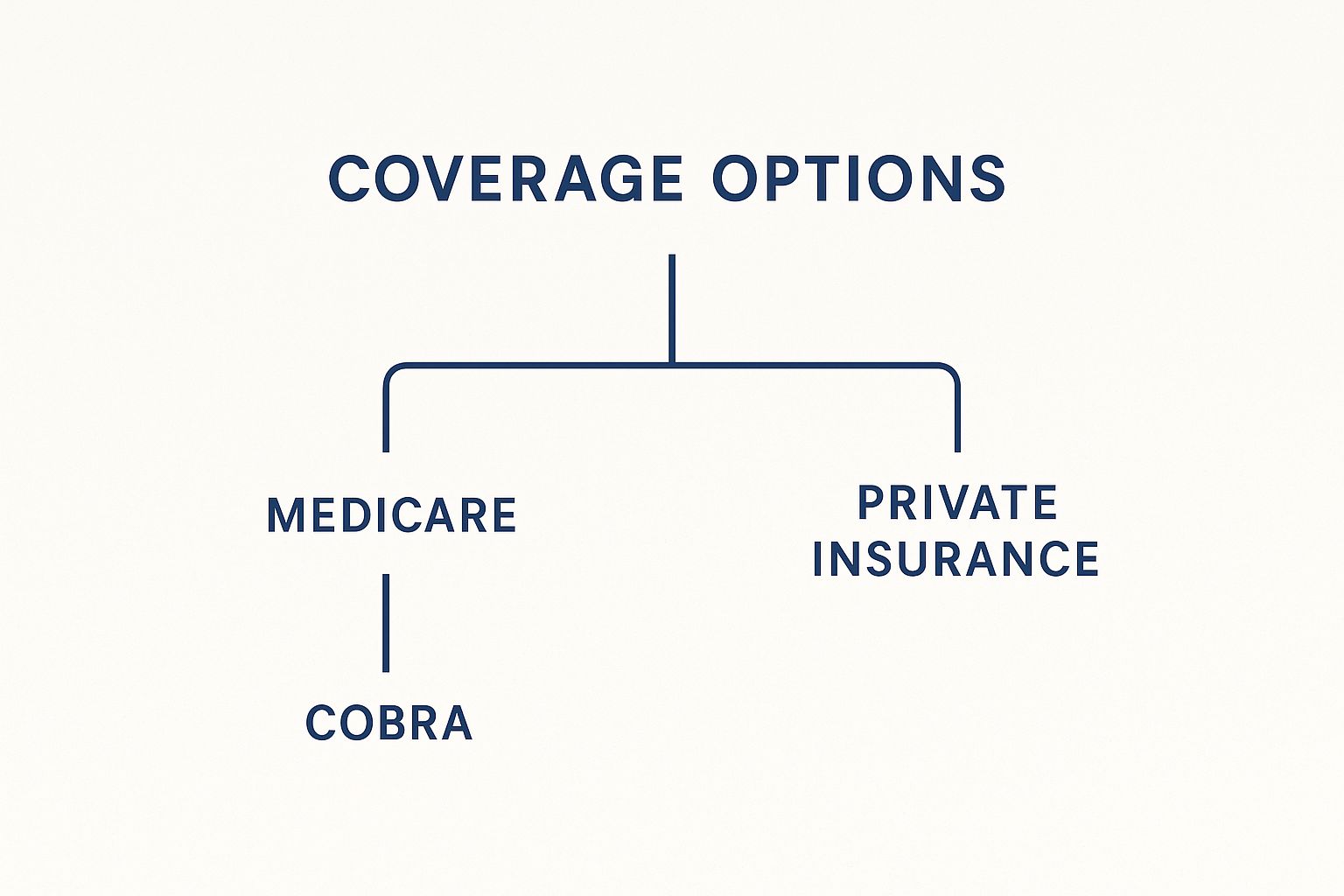Thinking about retiring before you turn 65? It’s an exciting thought, but there’s one big question you need to answer first: What about health insurance? Medicare doesn't kick in until your 65th birthday, leaving a critical gap you'll need to bridge on your own.
Most people find their way across this gap through one of three main routes: staying on their old employer's plan with COBRA, grabbing a plan from the Affordable Care Act (ACA) Marketplace, or buying a private plan directly from an insurer. The right path for you really comes down to your budget, your health, and whether you can get a little financial help along the way.
Why Planning for Pre-Medicare Healthcare Is So Important

Stepping into early retirement feels like freedom, but it can also open up a pretty scary gap in your health coverage. People often call the time between leaving your job and turning 65 the "pre-Medicare gap." For those few years, you're entirely responsible for finding and paying for your own health plan.
Ignoring this is a huge gamble. An unexpected illness or a simple accident without insurance can lead to medical bills so high they could unravel the financial security you spent a lifetime building. Medical debt is a tough reality for too many people, and it’s a risk no retiree should have to take. Think of this planning stage as building a safety net for both your health and your wallet.
Understanding Your Main Pathways
Figuring out health insurance for retirees under 65 doesn’t have to be a headache. Your options really boil down to three main choices, and each one has its own set of pros and cons.
- COBRA: This lets you keep the exact health plan you had at your old job for up to 18 months. It feels familiar, which is great, but be prepared for sticker shock. You'll now have to pay the full premium, including the part your employer used to cover.
- ACA Marketplace Plans: The Health Insurance Marketplace is a great place to shop for coverage. Depending on what your retirement income looks like, you might even qualify for big subsidies (premium tax credits) that can make your monthly payments much more affordable.
- Private Plans: You can also just buy a plan straight from an insurance company. This can sometimes give you more choices for doctors and hospitals, but you typically won't be able to get any of those income-based subsidies.
Your main goal here is simple: find solid coverage that protects you from a financial nightmare while still fitting into your new retirement budget. The right plan is like a bridge, getting you safely from your retirement date to your 65th birthday.
At the end of the day, the best choice is a personal one. You’ll need to weigh your retirement income, think about any medical care you might need, and decide if keeping your current doctors is a must-have. For a closer look at navigating this transition, our guide on securing health insurance before Medicare has even more tips.
Making a smart choice now means your early retirement years will be about freedom and peace of mind—not worrying about healthcare.
Your Primary Health Insurance Options Explained
When you retire before you turn 65, your health insurance journey takes a sharp turn. The familiar, single path of employer-sponsored coverage disappears, and suddenly you’re faced with a handful of different routes. Each one comes with its own price tag and reality of what’s covered. Getting a clear handle on these choices is the absolute first step to feeling confident about your healthcare during these pre-Medicare years.
This decision is a big deal. Here in the United States, retirees under 65 are in a unique spot. In 2025, while about 26.5% of people under 65 have public health insurance, a huge chunk of that (21.4%) is through Medicaid or CHIP. Medicare only steps in for about 2.9% of this age group, usually for people with specific disabilities. This leaves a massive coverage gap, made worse by the fact that employer-sponsored retiree health benefits have plummeted—from around 31% back in 2008 to as low as 12% in recent years. This trend has pushed more and more early retirees into a confusing and often expensive marketplace.
The diagram below lays out the main pathways you can take as an early retiree.

As you can see, your main choices stem from your old job, the government marketplace, or private insurance companies. Let's break down exactly what each of these really means for you.
To make things clearer, let's look at these options side-by-side. Each path has its own trade-offs, and what works for one person might not be the best fit for another.
Comparing Health Insurance Options for Early Retirees
| Option | Typical Cost | Coverage Length | Best For |
|---|---|---|---|
| COBRA | High (full premium + fee) | Up to 18 months | Short-term bridge, keeping doctors mid-treatment. |
| ACA Marketplace | Varies (often low with subsidies) | Annual (renews yearly) | Retirees with moderate income who need affordability. |
| Private Off-Exchange | High (full premium) | Annual (renews yearly) | Higher-income retirees who don't get subsidies but want specific doctors. |
| Short-Term Plan | Low | A few months (not renewable) | A temporary, last-resort safety net for a brief coverage gap. |
This table gives you a snapshot, but the devil is in the details. Let's dig deeper into what makes each one tick.
Option 1: COBRA Continuation Coverage
The Consolidated Omnibus Budget Reconciliation Act (COBRA) is probably the most familiar path. It lets you keep the exact same health plan you had with your old employer, usually for up to 18 months.
Think of it like this: you get to keep driving your old company car, but now you have to pay for the gas, insurance, maintenance, and the car payment all on your own. There’s a real comfort in that familiarity—you keep your doctors, your network, and all your benefits. The sticker shock, however, can be intense. You’re on the hook for 100% of the premium, plus a small administrative fee.
Key Takeaway: COBRA is a fantastic short-term bridge if you need to maintain continuity of care, especially if you’re in the middle of treatment. But its high cost makes it tough to sustain for the long haul.
Option 2: Affordable Care Act (ACA) Marketplace Plans
For many early retirees, the ACA Marketplace (also called the exchange) is the most budget-friendly route. This is where you can shop for different plans and—most importantly—get financial help to lower your monthly bills.
The magic ingredient here is the premium tax credit. This subsidy is tied directly to your Modified Adjusted Gross Income (MAGI). As a retiree, you suddenly have a lot more control over your income by deciding how and when to draw from your retirement accounts. That control can translate directly into major savings on your health insurance premiums.
Plus, ACA plans are required to cover essential health benefits and can't turn you away for pre-existing conditions. As you weigh your options, it's wise to stay informed about the shifting landscape of insurance coverage for pre-existing conditions, as policy changes can really impact your costs and access to care.
- Pro: You could save a lot of money through subsidies.
- Pro: You’re guaranteed coverage, even with pre-existing conditions.
- Con: You'll likely have to switch away from your old employer's plan and network.
- Con: Figuring out your income to qualify for subsidies takes some careful financial planning.
Learning to balance these pros and cons is key. For a more detailed walkthrough, check out our guide on how to compare health insurance plans—it's packed with practical tips for making a smart choice.
Option 3: Private Off-Exchange Plans
You also have the choice to buy a health plan directly from an insurance company or through a broker, completely outside the government marketplace. These "off-exchange" plans still have to meet the main ACA rules, like covering pre-existing conditions.
So, why would anyone go this route? Sometimes, insurance companies offer different plans off-exchange that might have bigger networks of doctors and hospitals. This could be a great fit if your income is too high to qualify for ACA subsidies and you’re set on keeping a specific doctor who isn't in the marketplace plans.
The catch is simple: no subsidies. You’ll be paying the full retail price for your coverage, period. This option really only makes sense for people with higher retirement incomes who care more about network flexibility than about saving money on premiums.
Option 4: Short-Term Health Insurance
Short-term plans are exactly what they sound like: a temporary, cheap option designed to fill a very short gap in coverage. They are absolutely not a real, long-term solution for health insurance for retirees under 65.
These plans don't have to follow ACA rules. That means they can—and almost always do—refuse to cover pre-existing conditions. They also often leave out critical benefits like prescription drugs, mental health services, or maternity care.
Only think about a short-term plan as a last-ditch safety net for a month or two, maybe while you’re waiting for your ACA plan to kick in. Trying to rely on one for your primary coverage during early retirement is a massive financial gamble that could leave you facing truly catastrophic medical bills.
Mastering the ACA Marketplace and Subsidies

For anyone looking to retire before age 65, the Affordable Care Act (ACA) Marketplace is more than just a website—it's the key to making it happen. This is where you can shop for and enroll in a health plan, either through HealthCare.gov or your state's dedicated site.
What makes this a game-changer for health insurance for retirees under 65? It’s all about the premium tax credit, which most people just call a subsidy. Because you're no longer earning a steady paycheck, you have more control over your income, and that’s the secret to unlocking major savings.
Think of an ACA subsidy like a personalized discount coupon for your health insurance. The value of that coupon is tied directly to your household's Modified Adjusted Gross Income (MAGI). The lower you can keep your MAGI, the bigger your subsidy gets, which means you pay less each month. It's that simple.
Your Income is the Key to Unlocking Savings
As a retiree, your "income" isn't what it used to be. It’s now a mix of Social Security, maybe a pension, and—most importantly—the money you pull from retirement accounts like a 401(k) or a traditional IRA. This gives you a massive advantage.
You can now strategically decide how much taxable income you’ll have each year. For instance, if you can live partly on withdrawals from a Roth IRA (which are tax-free) while taking smaller, taxable withdrawals from other accounts, you can push your MAGI way down. This isn't just a small tweak; this financial maneuvering can literally save you hundreds, if not thousands, of dollars a year on health insurance.
Example in Action:
Imagine a 62-year-old retired couple needs $60,000 a year to live comfortably. If they pull all $60,000 from a traditional 401(k), their MAGI is $60,000, and they'll get a decent subsidy.But what if they took $30,000 from their 401(k) and the other $30,000 from a Roth IRA? Suddenly, their MAGI is only $30,000. That much lower MAGI could qualify them for a significantly larger subsidy, slashing what they pay for health insurance each month.
This is exactly why income planning is so critical in early retirement. It’s not just about having enough money to live on; it’s about making your healthcare affordable.
Demystifying the Metal Tiers
When you start browsing the ACA Marketplace, you'll see plans labeled as Bronze, Silver, Gold, and Platinum. These names have nothing to do with the quality of medical care—you get the same doctors and hospitals. Instead, they describe how you and the insurance company will split the costs.
It’s a bit like picking a cell phone plan. You can choose a cheap monthly plan but pay a lot if you use too much data, or you can pay more upfront for unlimited everything.
-
Bronze Plans: These come with the lowest monthly premiums but the highest out-of-pocket costs like deductibles and copays. They’re a solid safety net for healthy folks who don't anticipate many doctor visits.
-
Silver Plans: This is the most popular choice for a good reason. Silver plans strike a balance with moderate premiums and moderate out-of-pocket costs. The real magic here is that only Silver plans offer extra savings called Cost-Sharing Reductions (CSRs) for those with lower incomes. CSRs actually lower your deductible and copays, making healthcare even more accessible.
-
Gold Plans: You’ll pay high monthly premiums for these, but your out-of-pocket costs will be low. If you know you'll need consistent medical care or have regular prescriptions, a Gold plan can often save you money over the year.
-
Platinum Plans: This is the top-shelf option. Platinum plans have the highest premiums and the lowest out-of-pocket costs. They're designed for people with significant and ongoing health needs who want the most predictable budget.
The right plan for you depends entirely on your health, your budget, and how much financial risk you’re comfortable taking on. For a deeper look at how to balance these factors, you can explore these affordable health insurance options.
Making Your Final Plan Selection
Okay, you've got a handle on your income and the metal tiers. Now it's time to pick your actual plan. Don't just grab the one with the lowest premium! You have to dig a little deeper.
Here’s a quick checklist to make sure you're making a smart choice:
- Check the Provider Network: Is your family doctor on the list? What about your preferred hospital? Make absolutely sure your must-have providers are "in-network," because going out-of-network can get very expensive, fast.
- Review the Formulary: If you take any medications, look up the plan’s formulary (its list of covered drugs). You need to know that your prescriptions are covered and what your copay will be.
- Calculate Total Potential Costs: This is a big one. Add the monthly premium for 12 months to the plan's out-of-pocket maximum. This number is your worst-case scenario for healthcare spending in a year—a crucial figure for any retirement budget.
By smartly managing your retirement income and understanding how the ACA Marketplace really works, you can turn a major financial worry into a predictable part of your retirement plan. That way, you get the healthcare you need without derailing your dreams.
Budgeting for Healthcare Costs in Early Retirement
Alright, you’ve picked a health insurance plan. That’s a huge win. But don't pop the champagne just yet—now we need to figure out how to pay for it without draining the nest egg you worked so hard to build.
This is where your healthcare budget becomes your best friend. It’s not just a spreadsheet; it’s your roadmap to financial peace of mind.
Let's be real: healthcare costs can be scary. Fidelity’s 2025 projections estimate that a 65-year-old retiring today will need about $172,500 for healthcare expenses in retirement. That number has more than doubled since 2002, which is a big deal if you're planning on being an early retiree under 65. It’s a bit jarring, especially since one in five Americans admits they've never even thought about these future costs. You can get a closer look at how these projections are calculated here.
But instead of letting that number intimidate you, let’s reframe it. Think of your healthcare budget as a predictable bill, just like your mortgage or groceries. Once you know the numbers, you take back control.
Building Your Healthcare Budget, Step by Step
This isn't about getting lost in complicated formulas. It’s about being prepared for both the monthly costs you know are coming and the "what-if" expenses that can show up unannounced.
Here’s a simple way to break it down:
-
Nail Down Your Premiums: This is the easy part. Take your monthly premium—the fixed price for your plan—and multiply it by 12. Boom. That’s your annual baseline.
-
Estimate Your Day-to-Day Costs: Now, look at your plan’s deductible, copays, and coinsurance. Think back on last year's medical spending. Were there regular prescriptions? A few specialist visits? Be honest about what you expect to need.
-
Know Your "Worst-Case" Number: Find your plan’s out-of-pocket maximum. This is the absolute ceiling on what you’ll pay for covered care in a year. Add your annual premiums to this number. This total is your maximum possible healthcare spending for the year—a critical figure for your financial plan.
Your Health Savings Account: The Ultimate Secret Weapon
If you were lucky enough to have a high-deductible health plan (HDHP) while you were working, hopefully, you were also stashing money away in a Health Savings Account (HSA). In early retirement, that HSA is no longer just a savings tool. It becomes a financial superpower.
Think of your HSA as your personal, tax-free medical fund. The money went in tax-free, it grew tax-free, and now you can pull it out tax-free for qualified medical expenses. It’s a triple-tax advantage that nothing else can touch.
An HSA is so much more than a savings account—it’s a strategic asset. You can use those funds for premiums (in certain cases, like with COBRA), deductibles, new glasses, or that dental crown you've been putting off, all without paying a dime in taxes.
This is a game-changer in early retirement. If you pull money from a 401(k) to cover a medical bill, it’s considered taxable income. That extra income could even shrink the ACA subsidy you qualify for. But when you use your HSA? It has zero impact on your income. Your subsidies stay safe, and your healthcare costs stay low.
Smart Moves to Manage Your Medical Bills
Having a solid plan and an HSA is fantastic, but a few savvy habits can stretch your dollars even further. These small moves can lead to big savings over time.
- Always, Always Stay In-Network: Before you book anything—a check-up, a specialist visit, a lab test—confirm they are in your plan’s network. Going out-of-network is the quickest way to get hit with a shocking bill.
- Go Generic: Don't be shy. Ask your doctor and pharmacist if a generic version of your prescription is available. They work the exact same way as brand-name drugs but often cost 80-85% less.
- Use Your Free Preventive Care: Your plan covers things like annual physicals, flu shots, and important screenings at zero cost to you. Use them! Catching something early is almost always easier and cheaper to treat.
- Read Your Bills: You'd be surprised how often mistakes happen. Always cross-reference the bill from your doctor with the Explanation of Benefits (EOB) from your insurer. Make sure you were charged correctly for the care you actually received.
When you pair a clear budget with smart tools like an HSA and everyday consumer-savvy, you’re no longer a passenger. You’re in the driver’s seat, ensuring that healthcare costs are just a predictable line item—not a threat to the retirement you’ve earned.
Your Step-by-Step Enrollment and Transition Plan
Okay, you've figured out your options. That’s the hard part. But knowing what to do and actually doing it are two different things. Let's walk through the practical steps to lock in your health coverage and make sure the transition is seamless.
The moment you leave your job, a clock starts ticking—and it’s a loud one. You generally have a 60-day Special Enrollment Period (SEP) to get into a COBRA or ACA Marketplace plan. If you miss that window, you could be left completely uninsured until the next open enrollment season. That's a gamble you just can't afford to take.
Your Essential Document Checklist
To make this whole process painless, get your paperwork in order before you start the application. Think of it like packing for a trip; having everything ready to go saves a ton of stress later.
Here’s what you’ll likely need:
- Proof of Income: This could be pension statements, a Social Security benefit letter, or even proof of withdrawals from your retirement accounts.
- Proof of Identity: A simple driver’s license or passport works perfectly.
- Letter of Creditable Coverage: This is the golden ticket. It's an official letter from your old job confirming you lost your health insurance, which is what unlocks your Special Enrollment Period.
- Social Security Numbers: Make sure you have them for everyone in your household who needs coverage.
Pro-tip: Scan these documents and save them on your computer. It makes online applications a breeze and prevents that last-minute scramble to find a piece of paper you thought was in a drawer somewhere.
The Transition from Your Bridge Plan to Medicare
The plan you choose now—whether it's COBRA or from the Marketplace—is just a bridge. It’s designed to get you from your job-based coverage to your ultimate destination: Medicare. You have to plan this handoff carefully to avoid gaps or, worse, lifelong penalties. Your Initial Enrollment Period for Medicare kicks off three months before your 65th birthday.
Timing is everything. Signing up for Medicare on time isn’t just a friendly suggestion. It's a critical deadline that can save you from paying late enrollment penalties on your Part B premiums for the rest of your life.
Once your Medicare is officially in place, you need to be the one to cancel your ACA or other private plan. It doesn't happen automatically. If you forget, you could end up paying for two plans at once and create a real mess with any premium tax credits you were receiving.
Here’s a simple timeline to keep in your back pocket:
- Three months before turning 65: Start the Medicare application process. Don't wait.
- Confirm your Medicare start date: It’s usually the first day of the month you turn 65.
- Cancel your existing plan: Call and schedule the cancellation to take effect the day before your Medicare coverage begins.
Following this strategy ensures you don't have a single day without coverage. Juggling all these dates can feel like a lot, I know. To get a better handle on these crucial timelines, you can read more about what open enrollment means for your insurance choices and how to stay ahead of them. This roadmap takes the guesswork out of the equation, setting you up for a secure and worry-free healthcare journey into retirement.
Frequently Asked Questions About Early Retiree Health Insurance

Stepping into early retirement is exciting, but figuring out health insurance for retirees under 65 can feel like a maze. You're not alone in your questions. Let's walk through some of the most common concerns we hear from people just like you, so you can move forward with confidence.
How Do Retirement Withdrawals Affect My ACA Subsidy?
This is a big one. Think of your eligibility for an ACA premium subsidy as being on a seesaw with your income—when one goes up, the other goes down. Every dollar you pull from a traditional 401(k) or IRA counts as taxable income, and that can shrink the subsidy you get.
This is where smart planning becomes your best friend. By carefully balancing what you withdraw from taxable accounts (like that 401(k)) with funds from non-taxable sources like a Roth IRA, you can manage your official income. It’s a simple strategy, but it can make a huge difference in the financial help you receive, making your monthly premiums much easier to handle.
What If My Spouse Is Still Working?
It’s a situation many early retirees find themselves in. If your working spouse has access to an affordable family health plan through their job, that usually takes ACA subsidies off the table for you. The government sees that employer plan as your first and best option for coverage.
But you still have a choice to make. You can either join your spouse’s plan, or, if that doesn't work for you, you can buy an ACA plan at its full price. The key is to run the numbers: what’s the cost to add you to their plan versus buying a separate one on your own?
Important Note: An employer plan is only considered "affordable" if the employee's share of the premium for self-only coverage is less than 8.39% of the household income. If their plan doesn't meet that specific standard, you might still be able to get subsidies on the Marketplace.
Are Pre-Existing Conditions Covered Before Age 65?
Yes. A thousand times, yes. This is one of the most important protections out there for early retirees. Thanks to the Affordable Care Act, any compliant health plan—whether you buy it on the Marketplace or directly from an insurance company—is legally required to cover your pre-existing conditions.
This guarantee means no one can deny you coverage or charge you a higher premium just because of your health history. It’s a critical safety net that separates these plans from short-term health insurance, which often doesn't cover pre-existing conditions and can leave you exposed to devastating financial risk.
Finding the right path for your health coverage is a vital piece of a happy, secure early retirement. At My Policy Quote, we specialize in helping retirees like you find plans that fit not just your health needs, but your budget too. Take the next step and explore your options by visiting https://mypolicyquote.com today.


